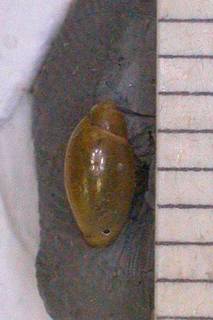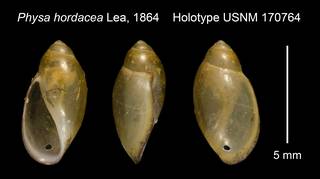MolluscaBase taxon details
Physella hordacea (I. Lea, 1864)
1308088 (urn:lsid:marinespecies.org:taxname:1308088)
accepted
Species
Physa hordacea I. Lea, 1864 · unaccepted (original combination)
recent only
(of Physa hordacea I. Lea, 1864) Lea I. (1864). Descriptions of twenty-four new species of <i>Physa</i> of the United States and Canada. <em>Proceedings of the Academy of Natural Sciences of Philadelphia.</em> 16: 114-116 [after 25 April 1864, before 30 June 1864]., available online at https://www.biodiversitylibrary.org/page/1942708
page(s): 116 [details]
page(s): 116 [details]
Note Vancouver Island, Fort Vancouver...
Etymology Latin hordeaceus, of barley, from hordeum, barley; presumably indicating the shell is like a barley-grain
Taxonomic remark Taylor (2003) considers this species as 'incertae sedis' and places it tentatively into the genus Physa.
Etymology Latin hordeaceus, of barley, from hordeum, barley; presumably indicating the shell is like a barley-grain [details]
Taxonomic remark Taylor (2003) considers this species as 'incertae sedis' and places it tentatively into the genus Physa.
Taxonomic remark Taylor (2003) considers this species as 'incertae sedis' and places it tentatively into the genus Physa. [details]
MolluscaBase eds. (2021). MolluscaBase. Physella hordacea (I. Lea, 1864). Accessed at: https://www.molluscabase.org/aphia.php?p=taxdetails&id=1308088 on 2025-09-11
Date
action
by
![]() The webpage text is licensed under a Creative Commons
Attribution 4.0 License
The webpage text is licensed under a Creative Commons
Attribution 4.0 License
original description
(of Physa hordacea I. Lea, 1864) Lea I. (1864). Descriptions of twenty-four new species of <i>Physa</i> of the United States and Canada. <em>Proceedings of the Academy of Natural Sciences of Philadelphia.</em> 16: 114-116 [after 25 April 1864, before 30 June 1864]., available online at https://www.biodiversitylibrary.org/page/1942708
page(s): 116 [details]
basis of record Johnson, P. D.; Bogan, A. E.; Brown, K. M.; Burkhead, N. M.; Cordeiro, J. R.; Garner, J. T.; Hartfield, P. D.; Lepitzki, D. A. W.; Mackie, G. L.; Tarpley, T. A.; Tiemann, J. S.; Whelan, N. V.; Strong, E. E. (2013). Conservation status of freshwater gastropods of Canada and the United States. <em>Fisheries.</em> 38(6): 247-282., available online at http://www.tandfonline.com/doi/abs/10.1080/03632415.2013.785396 [details] Available for editors [request]
[request]
additional source Taylor, D. W. (2003). Introduction to Physidae (Gastropoda: Hygrophila); biogeography, classification, morphology. <em>Revista de Biología Tropical.</em> 51(Suppl. 1): 1-263 (includes a Catalog of species, pp. 197-263)., available online at https://tropicalstudies.org/rbt/attachments/suppls/sup51-1%20Physidae/Physidae%20Information.pdf
page(s): 194 [details]
page(s): 116 [details]
basis of record Johnson, P. D.; Bogan, A. E.; Brown, K. M.; Burkhead, N. M.; Cordeiro, J. R.; Garner, J. T.; Hartfield, P. D.; Lepitzki, D. A. W.; Mackie, G. L.; Tarpley, T. A.; Tiemann, J. S.; Whelan, N. V.; Strong, E. E. (2013). Conservation status of freshwater gastropods of Canada and the United States. <em>Fisheries.</em> 38(6): 247-282., available online at http://www.tandfonline.com/doi/abs/10.1080/03632415.2013.785396 [details] Available for editors
additional source Taylor, D. W. (2003). Introduction to Physidae (Gastropoda: Hygrophila); biogeography, classification, morphology. <em>Revista de Biología Tropical.</em> 51(Suppl. 1): 1-263 (includes a Catalog of species, pp. 197-263)., available online at https://tropicalstudies.org/rbt/attachments/suppls/sup51-1%20Physidae/Physidae%20Information.pdf
page(s): 194 [details]
 Present
Present  Inaccurate
Inaccurate  Introduced: alien
Introduced: alien  Containing type locality
Containing type locality
From editor or global species database
Etymology Latin hordeaceus, of barley, from hordeum, barley; presumably indicating the shell is like a barley-grain [details]Taxonomic remark Taylor (2003) considers this species as 'incertae sedis' and places it tentatively into the genus Physa. [details]
Type locality Vancouver Island, Fort Vancouver [45º37’32”N, 122º39’25”W], Clark County, Washington, USA [details]
Type locality North America, from the Columbia River southward in the Willamette River valley, Oregon [details]
To ANSP Malacology Collection (syntypes of Physa hordacea. Lea, 1864. Proceedings of the Academy of Natural Sciences of Philadelphia 16 (2): 116 - catalog no. 17231) (from synonym Physa hordacea I. Lea, 1864)
To NMNH Extant Collection (IZ MOL 170764 Dorsal) (from synonym Physa hordacea I. Lea, 1864)
To NMNH Extant Collection (Physa hordacea Lea, 1864 Holotype USNM 170764) (from synonym Physa hordacea I. Lea, 1864)
To NMNH Extant Collection (IZ MOL 170764 Dorsal) (from synonym Physa hordacea I. Lea, 1864)
To NMNH Extant Collection (Physa hordacea Lea, 1864 Holotype USNM 170764) (from synonym Physa hordacea I. Lea, 1864)




